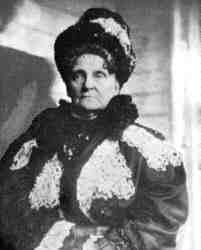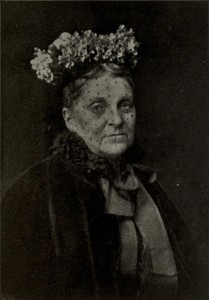
"Her appearance would never cause the uninitiated to think that she was anything more extraordinary than an old fashioned woman of moderate means and simple tastes."
Dubbed the “Witch of Wall Street,” Henrietta “Hetty” Green was the wealthiest woman in America in the early 1900s, a force in numerous aspects of the country’s economy, from railroads to real estate. But she was far more feared than loved. Oft-sued and consistently caricatured for her legendary cheapness, Green’s complicated portrait is painted to some degree in the following quartet of old print articles.
••••••••••
“Hetty Green’s Millions–Peculiar Dress and Tastes of a Widow Who Has Broken Banks,” Brooklyn Daily Eagle (September 17, 1893): “Not a small part of the fame of Brooklyn can be laid to the credit of the remarkable women who have lived and live now within its borders–women who have taken rank and honor in almost every walk of life. It is a well known fact that a very large proportion of the real estate in this city is held in the names of women. It is not a widely known fact that the woman who is reputed to be the richest in the United States lives in the City of Churches, and right in the classic section known as the Heights, too. Her wealth is variously estimated from $40,000,000 to $80,000,000 and her name is Mrs. Hetty Green. Her name and personality are more familiar to Wall Street than they are to Brooklyn society. That is because Mrs. Green has chosen to devote all her time to the manipulation of her fortune and has let society get along without her. Hetty Green at an Ihpetonga ball would create a sensation, indeed, but it is not likely that such an occasion will ever be recorded by society writers.
Nobody ever saw her with a dress which was not severely plain, and seldom has she been noticed when she did not carry an old style and well worn black satchel. Her appearance would never cause the uninitiated to think that she was anything more extraordinary than an old fashioned woman of moderate means and simple tastes, who was on her way to the corner grocery or the bakery on the block below. Yet, if money is power, this same staid looking person is one of the most powerful human beings in the country.”
••••••••••
“Hetty Green, Menaced, Arms Herself–Yet Only Things in the World She Fears, She Says, Are Lightning and a Religious Lawyer,” New York Times (May 9, 1902): “Mrs. Hetty R. Green, the richest woman in America, now carries a revolver. She says she has been threatened several times, and, as she frequently has much money and negotiable paper about her, she wants to be in a position to protect herself.
Mrs. Green, accompanied by a clerk from the Chemical National Bank, called at the Leonard Street Station on Saturday and applied for a permit to carry a pistol. Sergt. Isaac Frank was at the desk, and when he learned the identity of his callers he invited them to seats within the inclosure.
‘Now, young man,’ said Mrs. Green, ‘I want permission to carry a pistol. Because I am a rich woman some people might to kill me. I have often been threatened.'”
••••••••••
“Calls Hetty Green Stingy,” Brooklyn Daily Eagle (December 23, 1902): Mrs. J.H. Ives of Brooklyn, the stepmother of the ‘Napoleon of Finance’ Ives, is now in the ranks of those who declare Hetty Green, a ‘stingy woman.’ In fact, Mrs. Ives insists that Mrs. Green is the ‘stingiest woman on the face of this earth.’
Mrs. Ives’ assertion grows out of a transaction involving the loan of a chair and a sofa to Mrs. Green’s husband, now dead. Out of pity, she says, Mrs. Ives loaned the furniture to make Mr. Green more comfortable in his meagerly furnished room. She and Mrs. Green were schoolgirls together and this explains her interest in Mrs. Green’s husband.
‘I always like Edward Green and sympathized with him,’ said Mrs. Ives. ‘I knew what he had suffered at her hands Why, he couldn’t call his soul his own. He and his wife were not living together and he had a little room in the Cumberland, where the great Flatiron building now stands. He was sick and I called to see him. I was shocked at the surroundings in the wretched place. There was only a bed and a nightstand in the room and the poor fellow didn’t even have a chair to sit in, Still, he did not complain; he had lived with her too long to think of complaining.
Well, I loaned him a rocker and a sofa that had been in our family for many years. When he and his wife were reunited they went to Hoboken and my sofa and rocker went with them. After Mr. Green died last March, I asked Mrs. Green to return the things. Mrs. Green never gave me any satisfaction.”
••••••••••
“Hetty Green’s Husband Dead,” Brooklyn Daily Eagle (March 19, 1902): “Edward Green, husband of Hetty Green, died at his home to-day. He had been ill a long time with a complication of diseases. Edward Green, known wherever Mrs. Green went as ‘Hetty Green’s husband,’ lived at the Hotel St. George in Brooklyn during the winter of 1897-98 with Mrs. Green and her daughter Sylvia. Chief Clerk F.C. Niolo knew both Mr. and Mrs. Green very well and has been on very friendly terms with Mrs. Green ever since their stay at the St. George. He was greatly shocked to hear of Mr. Green’s death.
He said: ‘They were a very happy and contented couple. Mrs. Green was distinctly the man of the family and the head of the house.'”
••••••••••
Tags: Henrietta Green, Hetty Green

